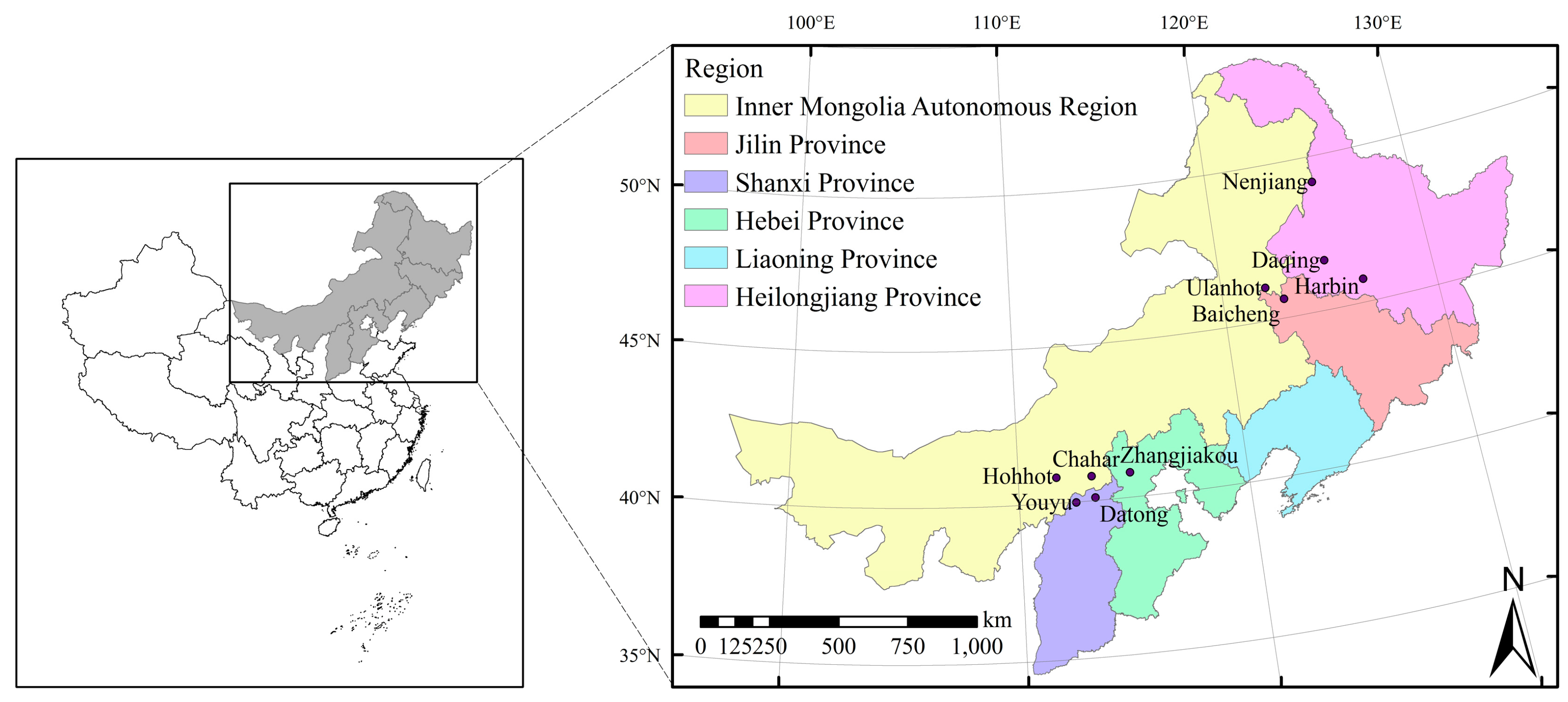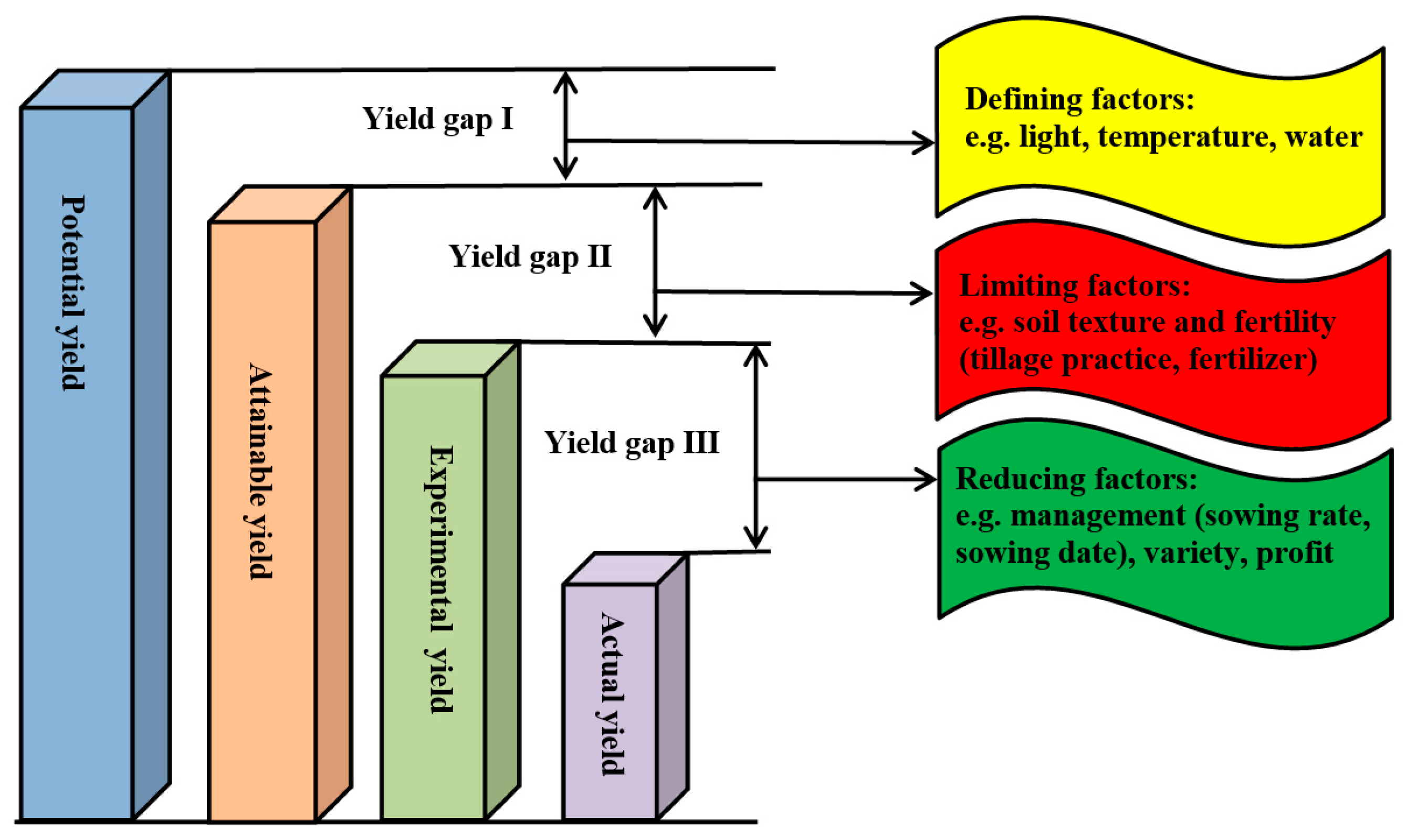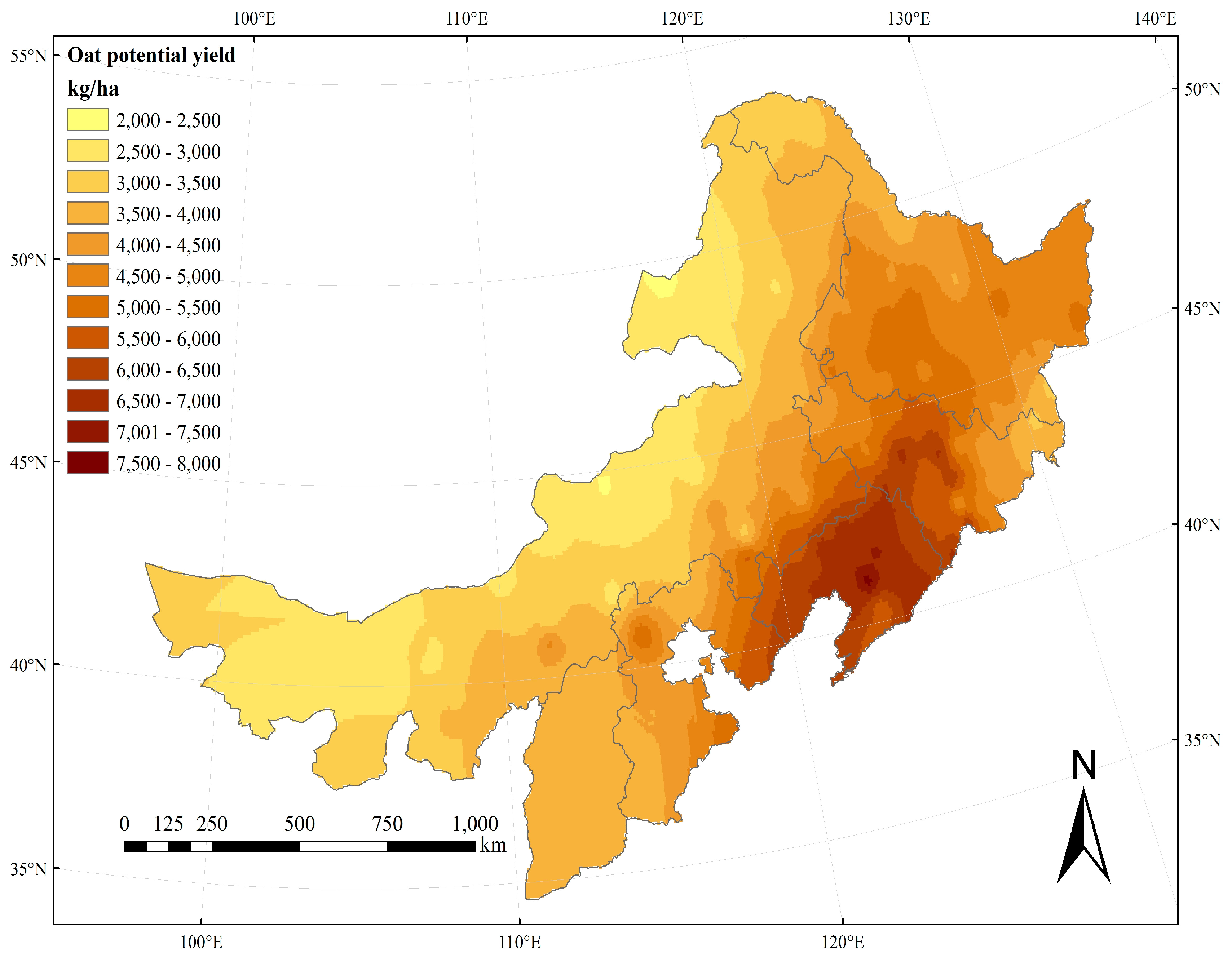Diagnosing the Climatic and Agronomic Dimensions of Rain-Fed Oat Yield Gaps and Their Restrictions in North and Northeast China
Abstract
1. Introduction
2. Materials and Methods
2.1. Study Area
2.2. Method of Evaluating Potential Productivity
2.3. Definitions and Quantification of Yield Gaps
2.4. Data Collection
3. Results
3.1. Potential Yield
3.2. Attainable Yield, Experimental Yield, and Actual Yield
3.3. Different Levels of Yield Gaps
4. Discussion
4.1. Potential Yield under Rain-Fed Systems
4.2. Yield Gaps and Their Limiting Factors
4.3. Approaches to Narrow Yield Gaps
5. Conclusions
Author Contributions
Funding
Acknowledgments
Conflicts of Interest
References
- Godfray, H.C.J.; Beddington, J.R.; Crute, I.R.; Haddad, L.; Lawrence, D.; Muir, J.F.; Pretty, J.; Robinson, S.; Thomas, S.M.; Toulmin, C. Food security: The challenge of feeding 9 billion people. Science 2010, 327, 812–818. [Google Scholar] [CrossRef]
- Lu, C.; Lan, F. Winter wheat yield potentials and yield gaps in the North China Plain. Field Crop. Res. 2013, 143, 98–105. [Google Scholar] [CrossRef]
- Mueller, N.D.; Gerber, J.S.; Johnston, M.; Ray, D.K.; Ramankutty, N.; Foley, J.A. Closing yield gaps through nutrient and water management. Nature 2012, 494, 254–257. [Google Scholar] [CrossRef] [PubMed]
- US Department of Agriculture, Foreign Agricultural Service (USDA-FAS). World Agricultural Production; USDA Foreign Agricultural Service: Washington, DC, USA, 2017.
- De Datta, S.K. Principles and Practices of Rice Production; Wiley: Hoboken, NJ, USA, 1981. [Google Scholar]
- Evans, L.T. Crop Evolution, Adaptation, and Yield; Cambridge University Press: Cambridge, UK, 1993. [Google Scholar]
- Mkvan, I.; Rabbinge, R. Concepts in production ecology for analysis and quantification of agricultural input-output combinations. Field Crop. Res. 1997, 52, 197–208. [Google Scholar]
- Evans, L.T.; Fischer, R.A. Yield Potential: Its Definition, Measurement, and Significance. Crop Sci. 1999, 39, 1544–1551. [Google Scholar] [CrossRef]
- Casanova, D.; Goudriaan, J.; Bouma, J.; Epema, G.F. Yield gap analysis in relation to soil properties in direct-seeded flooded rice. Geoderma 1999, 91, 191–216. [Google Scholar] [CrossRef]
- Liu, Z.; Yang, X.; Hubbard, K.G.; Lin, X. Maize potential yields and yield gaps in the changing climate of northeast China. Glob. Chang. Biol. 2012, 18, 3441–3454. [Google Scholar] [CrossRef]
- Lobell, D.B.; Cassman, K.G.; Field, C.B. Crop yield gaps: Their importance, magnitudes, and causes. Annu. Rev. Environ. Resour. 2009, 34, 179–204. [Google Scholar] [CrossRef]
- Hampf, A.C.; Carauta, M.; Latynskiy, E.; Libera, A.A.D.; Monteiro, L.; Sentelhas, P.; Troost, C.; Berger, T.; Nendel, C. The biophysical and socio-economic dimension of yield gaps in the southern Amazon—A bio-economic modelling approach. Agric. Syst. 2018, 165, 1–13. [Google Scholar] [CrossRef]
- Van Ittersum, M.K.; Cassman, K.G.; Grassini, P.; Wolf, J.; Tittonell, P.A.; Hochman, Z. Yield gap analysis with local to global relevance–A review. Field Crop. Res. 2013, 143, 4–17. [Google Scholar] [CrossRef]
- Lv, Z.F.; Liu, X.J.; Cao, W.X.; Zhu, Y. A Model-Based Estimate of Regional Wheat Yield Gaps and Water Use Efficiency in Main Winter Wheat Production Regions of China. Sci. Rep. 2017, 7, 6081. [Google Scholar] [CrossRef]
- Zhang, Z.; Lu, J.W.; Cong, R.H.; Ren, T.; Li, X.K. Publisher Correction: Evaluating agroclimatic constraints and yield gaps for winter oilseed rape (Brassica napus L.)—A case study. Sci. Rep. 2018, 8, 2746. [Google Scholar] [CrossRef] [PubMed]
- Licker, R.; Johnston, M.; Foley, J.A.; Barford, C.; Kucharik, C.J.; Monfreda, C.; Ramankutty, N. Mind the gap: How do climate and agricultural management explain the‘yield gap’ of croplands around the world? Glob. Ecol. Biogeogr. 2010, 19, 769–782. [Google Scholar] [CrossRef]
- Grassini, P.; Thorburn, J.; Burr, C.; Cassman, K.G. High-yield irrigated maize in the Western U.S. Corn Belt: I. On-farm yield, yield potential, and impact of agronomic practices. Field Crop. Res. 2011, 120, 142–150. [Google Scholar] [CrossRef]
- Wiberg, D.; Verelst, L.; Velthuizen, H.V.; Tóth, G.; Teixeira, E.; Prieler, S.; Nachtergaele, F.O.; Fischer, G. Global Agro-Ecological Zones (GAEZ v3. 0): Model Documentation; IIASA and FAO: Rome, Italy, 2012. [Google Scholar]
- Gohari, A.; Eslamian, S.; Abedi-Koupaei, J.; Bavani, A.M.; Wang, D.; Madani, K. Climate change impacts on crop production in Iran’s Zayandeh-Rud River Basin. Sci. Total Environ. 2013, 442, 405–419. [Google Scholar] [CrossRef]
- Balasubramanian, V.; Bell, M.; Sombilla, M. Yield, Profit and Knowledge Gaps in Rice Farming: Causes and Development of Mitigation Measures; Rap Publication (FAO); Regional Office for Asia and the Pacific: Bangkok, Thailand, 2000. [Google Scholar]
- Xu, X.P.; He, P.; Zhang, J.J.; Pampolino, M.F.; Johnston, A.M.; Zhou, W. Spatial variation of attainable yield and fertilizer requirements for maize at the regional scale in China. Field Crop. Res. 2017, 203, 8–15. [Google Scholar] [CrossRef]
- Masutomi, Y.; Takahashi, K.; Harasawa, H.; Matsuoka, Y. Impact assessment of climate change on rice production in Asia in comprehensive consideration of process/parameter uncertainty in general circulation models. Agric. Ecosyst. Environ. 2009, 131, 281–291. [Google Scholar] [CrossRef]
- Tian, Z.; Zhong, H.L.; Sun, L.X.; Fischer, G.; van Velthuizen, H.; Liang, Z.R. Improving performance of Agro-Ecological Zone (AEZ) modeling by cross-scale model coupling: An application to japonica rice production in Northeast China. Ecol. Model. 2014, 290, 155–164. [Google Scholar] [CrossRef]
- Sadras, V.O.; Mahadevan, M.; Zwer, P.K. Oat phenotypes for drought adaptation and yield potential. Field Crop. Res. 2017, 212, 135–144. [Google Scholar] [CrossRef]
- Bhatia, V.S.; Piara, S.; Wani, S.P.; Chauhan, G.S.; Rao, A.K.; Mishra, A.; Komuravelly, S. Analysis of potential yields and yield gaps of rainfed soybean in India using CROPGRO-Soybean model. Agric. For. Meteorol. 2008, 148, 1252–1265. [Google Scholar] [CrossRef]
- Duwayri, M.; Tran, D.V.; Nguyen, V.N. Reflections on yield gaps in rice production: How to narrow the gaps. Bridg. Rice Yield Gap Asia-Pac. Reg. 2000, 26–45. [Google Scholar]
- Food and Agriculture Organization (FAO). World Agriculture: Towards 2015/2030: An FAO Perspective; Earthscan Publication Ltd.: London, UK, 2003. [Google Scholar]
- Li, S.K.; Wang, C.T. Evolution and development of maize production techniques in China. Sci. Agric. Sin. 2009, 13, 1941–1951. (In Chinese) [Google Scholar]
- Chen, G.P.; Gao, J.L.; Zhao, M.; Dong, S.T.; Li, S.K.; Yang, Q.F.; Liu, Y.H.; Wang, L.C.; Xue, J.Q.; Liu, J.G.; et al. Distribution, Yield Structure, and Key Cultural Techniques of Maize Super-high Yield Plots in Recent Years. Acta Agron. Sin. 2012, 38, 80–85. (In Chinese) [Google Scholar] [CrossRef]
- Stuart, A.M.; Pame, A.R.P.; Silva, J.V.; Dikitanan, R.C.; Rutsaert, P.; Malabayabas, A.J.B.; Lampayan, R.M.; Radanielson, A.M.; Singleton, G.R. Yield gaps in rice-based farming systems: Insights from local studies and prospects for future analysis. Field Crop. Res. 2016, 194, 43–56. [Google Scholar] [CrossRef]
- Tao, F.L.; Zhang, S.; Zhang, Z.; Rotter, R.P. Temporal and spatial changes of maize yield potentials and yield gaps in the past three decades in China. Agric. Ecosyst. Environ. 2015, 208, 12–20. [Google Scholar] [CrossRef]
- Espe, M.B.; Cassman, K.G.; Yang, H.S.; Guilpart, N.; Grassini, P.; Van Wart, J.; Anders, M.; Beighley, D.; Harrell, D.; Linscombe, S. Yield gap analysis of US rice production systems shows opportunities for improvement. Field Crop. Res. 2016, 196, 276–283. [Google Scholar] [CrossRef]
- Silva, J.V.; Reidsma, P.; Laborte, A.G.; van Ittersum, M.K. Explaining rice yields and yield gaps in Central Luzon, Philippines: An application of stochastic frontier analysis and crop modelling. Eur. J. Agron. 2017, 82, 223–241. [Google Scholar] [CrossRef]
- Sun, H.Y.; Zhang, X.Y.; Chen, S.Y.; Pei, D.; Liu, C.M. Effects of harvest and sowing time on the performance of the rotation of winter wheat–summer maize in the North China Plain. Ind. Crop. Prod. 2007, 25, 239–247. [Google Scholar] [CrossRef]
- Kucharik, C.J. Contribution of planting date trends to increased maize yields in the central United States. Agron. J. 2008, 100, 32–336. [Google Scholar] [CrossRef]
- Ren, C.Z. Photothermal Characterization of Naked Oat Genotypes with Different Maturity Types; China Agricultural University: Beijing, China, 2010. (In Chinese) [Google Scholar]
- Ramos, M.E.; Altieri, M.A.; Garcia, P.A.; Robles, A.B. Oat and Oat-Vetch as Rainfed Fodder-Cover Crops in Semiarid Environments: Effects of Fertilization and Harvest Time on Forage Yield and Quality. J. Sustain. Agric. 2011, 35, 726–744. [Google Scholar] [CrossRef]
- Hedayetullah, M.; Barik, A.K. Influence of cutting and fertilizer management on growth and yield of fodder oats (Avena sativa L.). Madras Agric. J. 2012, 99, 711–714. [Google Scholar]
- Buerstmayr, H.; Krenn, N.; Stephan, U.; Grausgruber, H.; Zechner, E. Agronomic performance and quality of oat (Avena sativa L.) genotypes of worldwide origin produced under Central European growing conditions. Field Crop. Res. 2007, 101, 343–351. [Google Scholar] [CrossRef]
- Martinez, M.F.; Arelovich, H.M.; Wehrhahne, L.N. Grain yield, nutrient content and lipid profile of oat genotypes grown in a semiarid environment. Field Crop. Res. 2010, 116, 92–100. [Google Scholar] [CrossRef]
- Collins, M.; Brinkman, M.A.; Salman, A.A. Forage yield and quality of oat cultivars with increasing rates of nitrogen fertilization. Agron. J. 1990, 82, 724–728. [Google Scholar] [CrossRef]
- May, W.E.; Mohr, R.M.; Lafond, G.P.; Johnston, A.M.; Stevenson, F.C. Effect of nitrogen, seeding date and cultivar on oat quality and yield in the eastern Canadian prairies. J. Plant Sci. 2004, 84, 1025–1036. [Google Scholar] [CrossRef]
- Mohr, R.M.; Grant, C.A.; May, W.E. Nitrogen, phosphorus, and potassium fertilizer management for oats. Better Crop. 2004, 88, 12–14. [Google Scholar]
- Mohr, R.M.; Grant, C.A.; May, W.E.; Stevenson, F.C. The influence of nitrogen, phosphorus and potash fertilizer application on oat yield and quality. Can. J. Soil Sci. 2007, 87, 459–468. [Google Scholar] [CrossRef]
- Rivera-reyes, J.G.; Cortez-Baheza, E.; Peraza-Luna, F.A.; Serratos-Arevalo, J.C.; Posos-Ponce, P.; Guevara-Gonzalez, R.G.; Torres-Pacheco, I.; Guzman-Maldonado, S.H. Agronomic Traits Associated to Yield and Quality in Oat Seeds. Asian J. Plant Sci. 2008, 7, 767–770. [Google Scholar]
- Sadras, V.O.; Mahadevan, M.; Zwer, P.K. Intraspecific competition in oat varieties selected for grain yield and milling. Crop Pasture Sci. 2018, 69, 673–680. [Google Scholar] [CrossRef]
- Chapagain, T.; Good, A. Yield and Production Gaps in Rainfed Wheat, Barley, and Canola in Alberta. Front. Plant Sci. 2015, 6, 990. [Google Scholar] [CrossRef]
- De Bie, C.A.J.M. Comparative Performance an Analysis of Agro-Ecosystems; Wageningen Agricultural University: Wageningen, The Netherlands, 2000. [Google Scholar]





| Sites | Soil Types | Total-N (g/kg) | Available P (mg/kg) | Available K (mg/kg) | pH | Sowing Date | Harvest Date |
|---|---|---|---|---|---|---|---|
| Youyu | Chestnut soil | 0.50 | 27.41 | 88.00 | 8.23 | 15 April | 15 July |
| ZhangJiakou | Chestnut soil | 1.06 | 13.10 | 118.00 | 7.90 | 5 April | 25 June |
| Hohhot | Chestnut soil | 0.53 | 6.68 | 105.20 | 8.47 | 15 April | 13 July |
| Chahar | Chestnut soil | 0.52 | 10.50 | 90.80 | 8.30 | 15 April | 13 July |
| Datong | Chestnut soil | 0.89 | 5.66 | 71.00 | 8.43 | 15 April | 13 July |
| Baicheng | Chernozem soil | 0.80 | 9.90 | 76.60 | 8.20 | 10 April | 15 July |
| Harbin | Black soil | 0.98 | 18.32 | 109.27 | 7.50 | 10 April | 15 July |
| Nenjiang | Black soil | 1.14 | 28.37 | 154.50 | 8.24 | 25 April | 10 August |
| Daqing | Black soil | 0.74 | 11.40 | 94.70 | 8.30 | 10 April | 15 July |
| UlanHot | Aeolian sandy soil | 0.37 | 3.81 | 78.51 | 8.00 | 22 April | 15 July |
| Mean | Maximum | Minimum | |||||
|---|---|---|---|---|---|---|---|
| NC | NEC | NC | NEC | NC | NEC | ||
| Yield (kg/ha) | Yp | 4304 | 4389 | 5320 | 4863 | 3680 | 3830 |
| Yt | 3369 | 3571 | 3691 | 3786 | 2916 | 3416 | |
| Ye | 2317 | 2396 | 2490 | 2602 | 2034 | 2265 | |
| Ya | 989 | 1656 | 1230 | 1800 | 795 | 1462 | |
| Yield gap (kg/ha) | YG-I | 935 | 818 | 1697 | 1182 | 643 | 285 |
| YG-II | 1051 | 1175 | 1303 | 1436 | 786 | 814 | |
| YG-III | 1328 | 740 | 1443 | 944 | 1197 | 551 | |
| Yield gap percentage | YG-I% | 21% | 18% | 32% | 25% | 16% | 7% |
| YG-II% | 31% | 33% | 39% | 38% | 24% | 24% | |
| YG-III% | 58% | 31% | 62% | 39% | 50% | 23% | |
© 2019 by the authors. Licensee MDPI, Basel, Switzerland. This article is an open access article distributed under the terms and conditions of the Creative Commons Attribution (CC BY) license (http://creativecommons.org/licenses/by/4.0/).
Share and Cite
Wang, C.; Liu, J.; Li, S.; Zhang, T.; Shi, X.; Zeng, Z.; Lei, Y.; Chu, Q. Diagnosing the Climatic and Agronomic Dimensions of Rain-Fed Oat Yield Gaps and Their Restrictions in North and Northeast China. Sustainability 2019, 11, 2104. https://doi.org/10.3390/su11072104
Wang C, Liu J, Li S, Zhang T, Shi X, Zeng Z, Lei Y, Chu Q. Diagnosing the Climatic and Agronomic Dimensions of Rain-Fed Oat Yield Gaps and Their Restrictions in North and Northeast China. Sustainability. 2019; 11(7):2104. https://doi.org/10.3390/su11072104
Chicago/Turabian StyleWang, Chong, Jiangang Liu, Shuo Li, Ting Zhang, Xiaoyu Shi, Zhaohai Zeng, Yongdeng Lei, and Qingquan Chu. 2019. "Diagnosing the Climatic and Agronomic Dimensions of Rain-Fed Oat Yield Gaps and Their Restrictions in North and Northeast China" Sustainability 11, no. 7: 2104. https://doi.org/10.3390/su11072104
APA StyleWang, C., Liu, J., Li, S., Zhang, T., Shi, X., Zeng, Z., Lei, Y., & Chu, Q. (2019). Diagnosing the Climatic and Agronomic Dimensions of Rain-Fed Oat Yield Gaps and Their Restrictions in North and Northeast China. Sustainability, 11(7), 2104. https://doi.org/10.3390/su11072104






